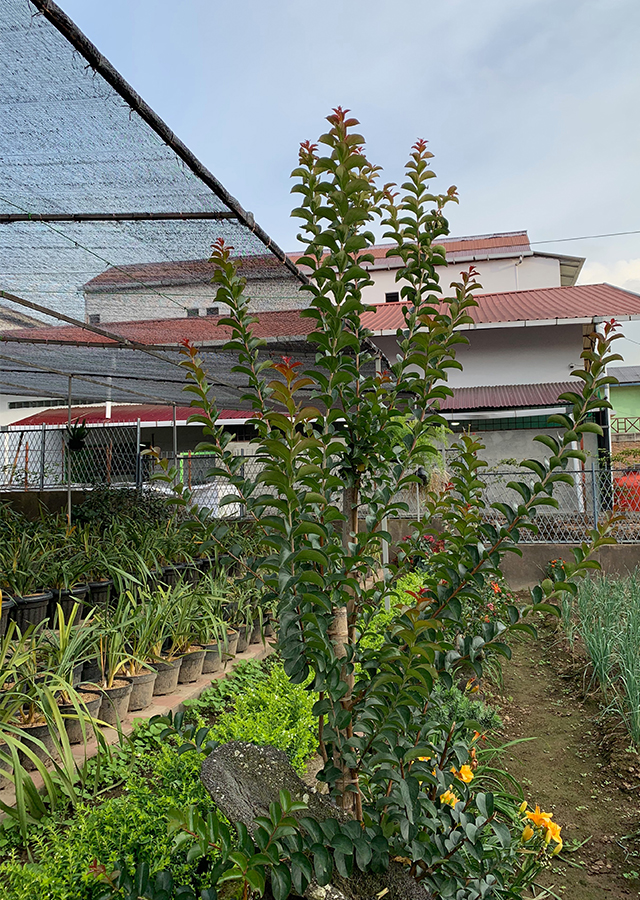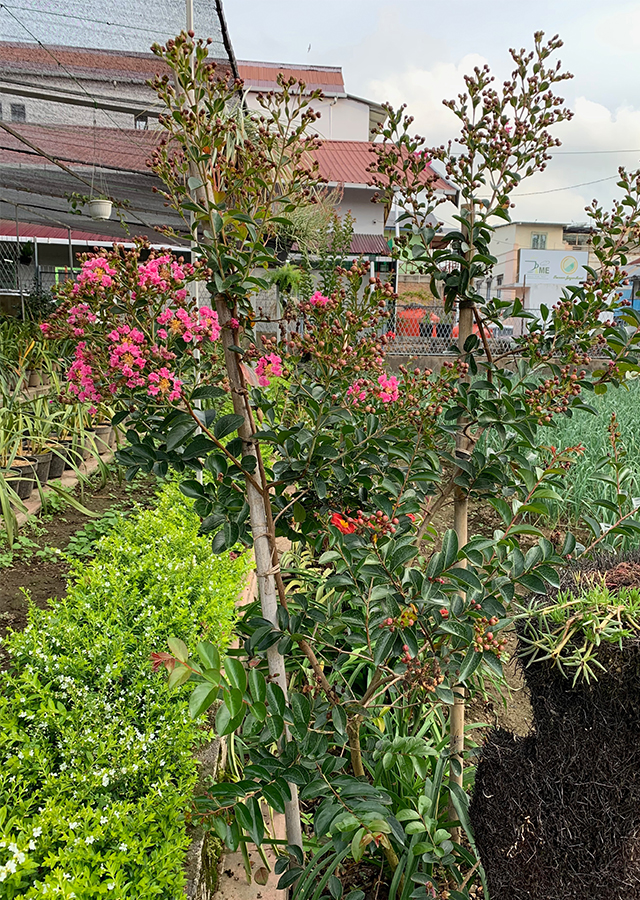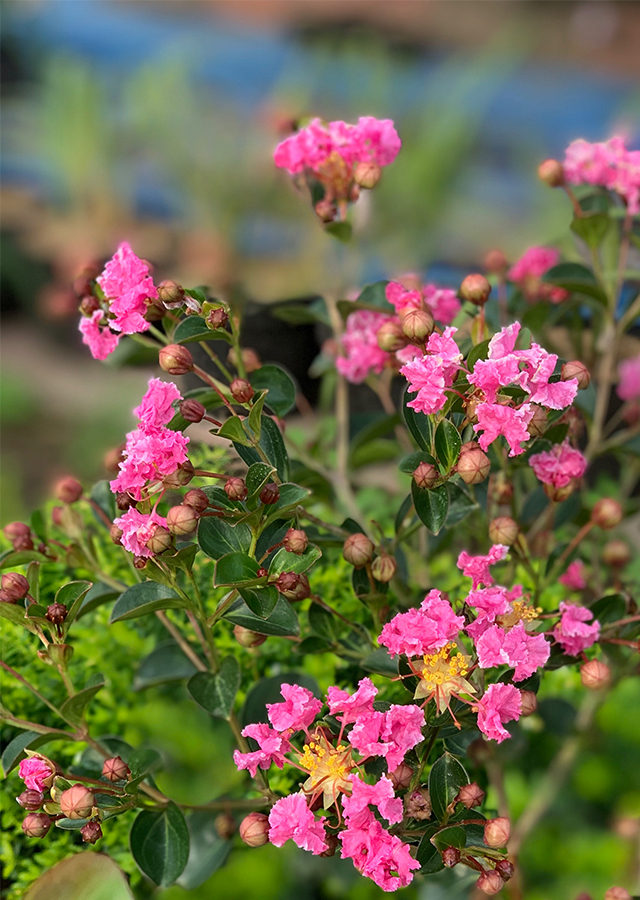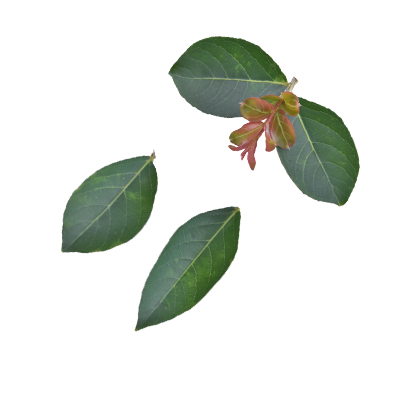Crape Myrtle
Lagerstroemia indica L.
Lythraceae
Location in our garden
Principal



Synonym
Lagerstroemia chinensis L.
Lagerstroemia elegans Wall. ex Paxton
Murtughas indica (L.) Kuntze
Habitus
Shrubs. A deciduous shrub or small tree with an upright branches, perennial, vase-shaped crown, grow from 3 - 8 m tall.
Part Used
Leaves
Bark
Flowers
Roots
Growing Requirements
Full Sunshine
Need Shade
Drought Resistant
Habitat
Riverbanks
Forest
Shrublands
Grassland
Overview
Crepe myrtle is native from the Himalayas through southern China, South-East Asia and Japan, but has naturalised in the U.S. The plant is found growing in gardens, yards, public parks, buffer strips around parking lots, along highways, grasslands, along rivers, in disturbed or secondary forest.
Vernacular Names
Pan-ei (Burmese), Tzu hui (Chinese), Lagerstroemia (Ducth), Lilas d'été (French), Kreppmyrte (German), Sarusuberi (Japanese), Bae long na mu (Korean), Bungur kecil (Malay), Melendres (Tagalog-Philippines), Dta baek (Thai).
Agroecology
A plant of the warm temperate zone, but is widely cultivated from the temperate zone to the tropics. It is commonly planted in gardens, yards, public parks, buffer strips around parking lots, and along highways. Dormant plants are hardy to about -10 °C if the wood is well ripened. It requires a very hot and humid summers to do well. Succeeds in most well-drained soils in a sunny sheltered position, in soils low in nutrients and dislikes very alkaline soils.
Morphology
- Roots - tap root with a lot of lateral roots.
- Stems - branches are slender, 4-angled, and narrowly winged, puberulous, glabrescent.
- Leaves - entire, stalkless, obovate, elliptic-ovate to oblong-ovate, 4 to 8 cm long.
- Flowers - white, pink or purplish, about 4 cm in diameter, borne on small, terminal panicles. Flowers give way to 6-capsules globose-ovoid, about 1 cm long fruits.
- Seeds - including wing approximately 8 mm.
Cultivation
- By seeds - best sown as soon as it is ripe. When they are large enough to handle, prick the seedlings out into individual pots and grow them on until large enough to plant out.
- Cuttings of half-ripe wood, 5-8 cm with a heel. fair to good percentage.
- Root cuttings 4 cm long and give a high percentage of success.
Chemical Constituents
Brevifolin, decarboxy ellagic acid, polyphenolics, tellimagrandin, nilocitin, astralagi, rutin, catechin, terpenoids, tannins, deoxysugars, saponins, flavonoids (flavanones/ dihydroflavonols and chalcones), quercetin, pigenin, alkaloids, cardiac glycosides, sterols, triterpenes, anthraquinones, and phenolic glycosides (strosides A–C).
Traditional Medicinal Uses
- Lagerstroemia indica showed anti-inflammatory, analgesic, antipyretic, antioxidant, anticancer, antimicrobial, anti-Alzheimer's, antidiabetic, hepatoprotective, and antithrombin effects.
- The root is astringent, detoxicant, and diuretic.
- The stem bark is febrifuge, stimulant, and styptic.
- Roots, leaves, and flowers are purgative.
- Prevent cancer cells growth, maintain bones health, beneficial for constipation, overcome inflammation, stroke, diabetes, coughing up blood, toothache, diarrhoea, and kidney stone.
- Works as antivirus, prevent premature aging, antidote for high blood pressure level, cure for urinary conditions, avoid thrombus, prevent heart attack, prevent arteriosclerosis disease, decrease the level of blood cholesterol, maintain skin health, release toxic from the body.
- A paste of the flowers is applied externally to cuts and wounds.
- A decoction of the flowers is used in the treatment of colds.
- In India, decoction of roots considered astringent, used as gargle.
Part Used
Reference Sources
- Ilmubudidaya.com. 2017. 6 Cara Menanam Bunga Bungur sebagai Tanaman Herbal Berkhasiat. https://ilmubudidaya.com/cara-menanam-bunga-bungur 21-04-2020
- Khasiat Tumbuhan. 2014.Manfaat Tanaman Bungur Kecil. http://khasiat-tumbuhan.blogspot.com/2014/04/manfaat-tanaman-bungur-kecil.html 03-05-2020



